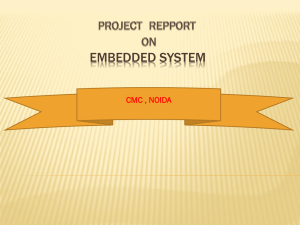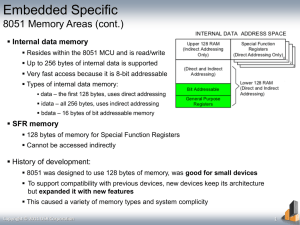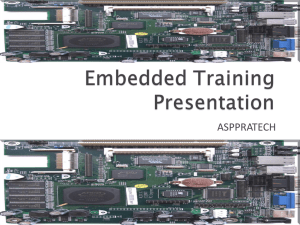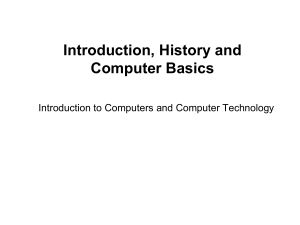Chapter 2
advertisement
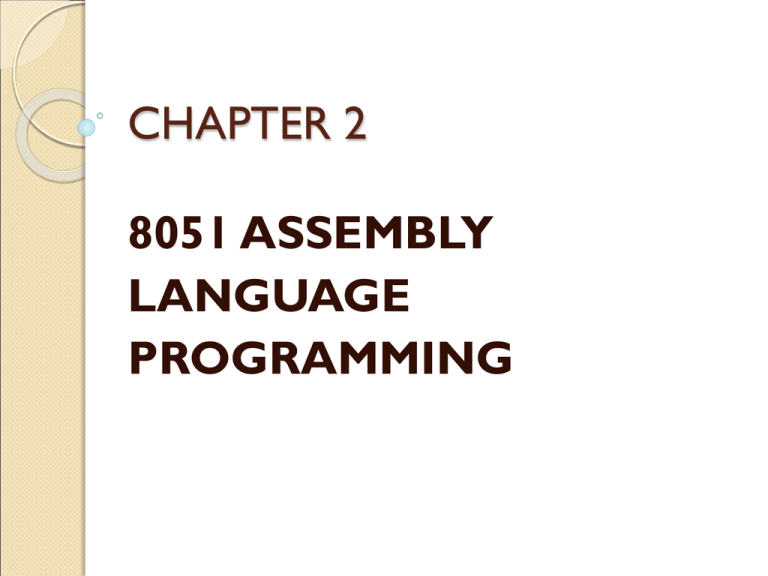
CHAPTER 2 8051 ASSEMBLY LANGUAGE PROGRAMMING Registers Register are used to store information temporarily: ◦ A byte of data to be processed ◦ An address pointing to the data to be fetched The vast majority of 8051 register are 8bit registers ◦ There is only one data type, 8 bits ◦ The 8 bits of a register are labeled from MSB D7 to the LSB D0 Registers (cont.) Any data larger than 8 bits must be broken into 8-bit chunks before it is processed Registers (cont.) The most widely used registers: ◦ A (Accumulator) For all arithmetic and logic instructions ◦ B, R0, R1, R2, R3, R4, R5, R6, R7 ◦ DPTR (data pointer) ◦ PC (program counter) Registers (cont.) MOV Instruction MOV destination, source ;copy source to dest. ◦ The instruction tells the CPU to move (in reality, COPY) the source operand to the destination operand MOV Instruction (cont.) Notes on programming ◦ Value (proceeded with #) can be loaded directly to registers A, B, or R0 – R7 MOV Instruction (cont.) If #23H is not preceded with #, it means to load from a memory location For #0F9H, add a 0 to indicate F is a hex number and not a letter ◦ If values 0 to F moved into an 8-bit register, the rest of the bits are assumed all zeros “MOV A, #5”, the result will be A=05 i.e., A = 00000101 in binary ◦ Moving a value that is too large into a register will cause an error MOV A, #7F2H ILLEGAL: 7F2H > 8 bits (FFH) ADD Instruction ADD A, source ;ADD the source operand to the accumulator ◦ The ADD instruction tells the CPU to add the source byte to register A and put the result in register A ◦ Source operand can be either a register or immediate data, but the destination must always be register A ◦ ADD R4, A” and “ADD R2, #12H” are invalid since A must be the destination of any arithmetic operation ADD Instruction (cont.) Structure of Assembly Language In the early days of the computer, programmers coded in machine language ◦ Consisting of 0s and 1s Tedious, slow and prone to error Assembly languages provide mnemonics for the machine code instructions, plus other features ◦ An assembly language program consist of a series of lines of assembly language instructions Structure of Assembly Language (cont.) Assembly language is referred to as a lowlevel language ◦ It deals directly with the internal structure of the CPU Assembly language instruction includes: ◦ A mnemonic (abbreviation easy to remember) The commands to the CPU, telling it what those to do with those items ◦ Optionally followed by one or two operands The data items being manipulated Structure of Assembly Language (cont.) A given assembly language program is a series of statements, or lines ◦ Assembly language instructions Tell the CPU what to do ◦ Directives (or pseudo-instructions) Give directions to the assembler An Assembly language instruction consists of four fields: [label:] Mnemonic [operands] [;comment] Structure of Assembly Language (cont.) ◦ Directives do not generate any machine code and are used only by the assembler ◦ Mnemonics produce opcodes ◦ The label field allows the program to refer to a line of code by name ◦ Comments may be at the end of a line or on a line by themselves The assembler ignores comments Structure of Assembly Language (cont.) Steps to Create a Program abs and hex Files The linker program takes one or more object code files and produce an absolute object file ◦ With the extension “abs” ◦ This abs file is used by 8051 trainers that have a monitor program Next the “abs” file is fed into a program called “OH” (object to hex converter) ◦ Creating a file with extension “hex” that is ready to burn into ROM lst File The lst (list) file lists all the opcodes and addresses as well as errors that the assembler detected ◦ The programmer uses the lst file to find the syntax errors or debug Program Counter The program counter points to the address of the next instruction to be executed ◦ As the CPU fetches the opcode from the program ROM, the program counter is increasing to point to the next instruction The program counter is 16 bits wide ◦ This means that it can access program addresses 0000 to FFFFH A total of 64K bytes of code Power up All 8051 members start at memory address 0000 when they’re powered up ◦ Program Counter has the value of 0000 ◦ The first opcode is burned into ROM address 0000H This is where the 8051 looks for the first instruction when it is booted We achieve this by the ORG statement in the source program Placing Code in ROM Placing Code in ROM (cont.) After the program is burned into ROM, the opcode and operand are placed in ROM memory location starting at 0000 Executing a program byte by byte Assuming that the above program is burned into the ROM of an 8051 chip (or 8751, AT8951, or DS5000), the following is a step-by-step description of the action of the 8051 upon applying power to it. 1. When the 8051 is powered up, the PC (program counter) has 0000 and starts to fetch the first opcode from location 0000 of the program ROM. 2. Upon executing the opcode 7D, the value 25H is moved into R5. Then the program counter is incremented to 0002. 3. Upon executing the opcode 7F, the value 34H is moved into R7. Then the program counter is incremented to 0004. 4. ROM location 0004 has the opcode for the instruction “MOV A,#0”. This instruction is executed and now PC = 0006. 5. Now PC = 0006 points to the next instruction, which is “ADD A,R5”. This is a 1-byte instruction. 6.The location 0007 has the opcode 2F, which belongs to the instruction “ADD A,R7”. This also is a 1-byte instruction. ROM Memory Map in 8051 Family No member of 8051 family can access more than 64K bytes of opcode ◦ The program counter is a 16-bit register Data Type 8051 microcontroller has only one data type - 8 bits ◦ The size of each register is also 8 bits ◦ It is the job of the programmer to break down data larger than 8 bits 00 to FFH, or 0 to 255 in decimal ◦ The data types can be positive or negative Program Status Word The program status word (PSW) register is an 8 bit register ◦ Also referred to as the flag register ◦ Only 6 bits are used These four are called conditional flags They indicate some conditions that resulted after an instruction is executed CY (carry): Carry out from the D7 bit AC (auxiliary carry): A carry from D3 to D4 P (parity): Reflect the number of 1s in register A Program Status Word (cont.) ◦ OV (overflow): The result of signed number operation is too large, causing the high-order bit to overflow into the sign bit The PSW3 and PSW4 are designed as RS0 and RS1 ◦ Used to change the bank The two unused bits are user-definable The flag bits affected by the ADD instruction are CY, P, AC, and OV RAM Memory Space Allocation There are 128 bytes of RAM in the 8051 ◦ Assigned addresses 00 to 7FH ◦ Divided into three different groups as follows: 1) A total of 32 bytes from locations 00 to 1F hex are set aside for register banks and the stack 2) A total of 16 bytes from locations 20H to 2FH are set aside for bit-addressable read/write memory 3) A total of 80 bytes from locations 30H to 7FH are used for read and write storage Called scratch pad RAM Memory Space Allocation (cont.) Register Banks These 32 bytes are divided into 4 banks of registers ◦ Each bank has 8 registers, R0-R7 ◦ RAM location from 0 to 7 are set aside for bank 0 of R0-R7 R0 is RAM location 0, R1 is RAM location 1, R2 is RAM location 2, and so on, until memory location 7 which belongs to R7 of bank 0 It is much easier to refer to these RAM locations with names such as R0, R1, and so on, than by their memory locations Register Banks (cont.) Register bank 0 is the default when 8051 is powered up Register banks and their RAM address Register Banks (cont.) We can switch to other banks by use of the PSW register ◦ Bits D4 and D3 of the PSW are used to select the desired register bank Use the bit-addressable instructions SETB and CLR to access PSW.4 and PSW.3 Stack The stack is a section of RAM used by the CPU to store information temporarily ◦ This information could be data or an address The register used to access the stack is called the SP (stack pointer) register ◦ The stack pointer in the 8051 is 8 bit wide It can only take value of 00 to FFH When the 8051 is powered up, the SP register contains value 07 Stack (cont.) ◦ RAM location 08 is the first location begin used for the stack by the 8051 The storing of a CPU register in the stack is called a PUSH ◦ SP is pointing to the last used location of the stack ◦ As we push data onto the stack, the SP is incremented by one ◦ This is different from many microprocessors Stack (cont.) Loading the contents of the stack back into a CPU register is called a POP ◦ With every pop, the top byte of the stack is copied to the register specified by the instruction ◦ The stack pointer is decremented once = 54 = F9 = 76 CALL Instruction And Stack The CPU also uses the stack to save the address of the instruction just below the CALL instruction ◦ This is how the CPU knows where to resume when it returns from the called subroutine Incrementing Stack Pointer The reason of incrementing SP after push: ◦ Make sure that the stack is growing toward RAM location 7FH From lower to upper addresses ◦ Ensure that the stack will not reach the bottom of RAM and run out of stack space ◦ If the stack pointer were decremented after push We would be using RAM locations 7, 6, 5, etc. which belong to R7 to R0 of bank 0, the default register bank Stack and Bank 1 Conflict When 8051 is powered up, register bank 1 and the stack are using the same memory space ◦ Because locations 08-1FH of RAM are reserved for register bank 1 ◦ We can reallocate another section of RAM to the stack By using the instruction “MOV SP, #XX”

